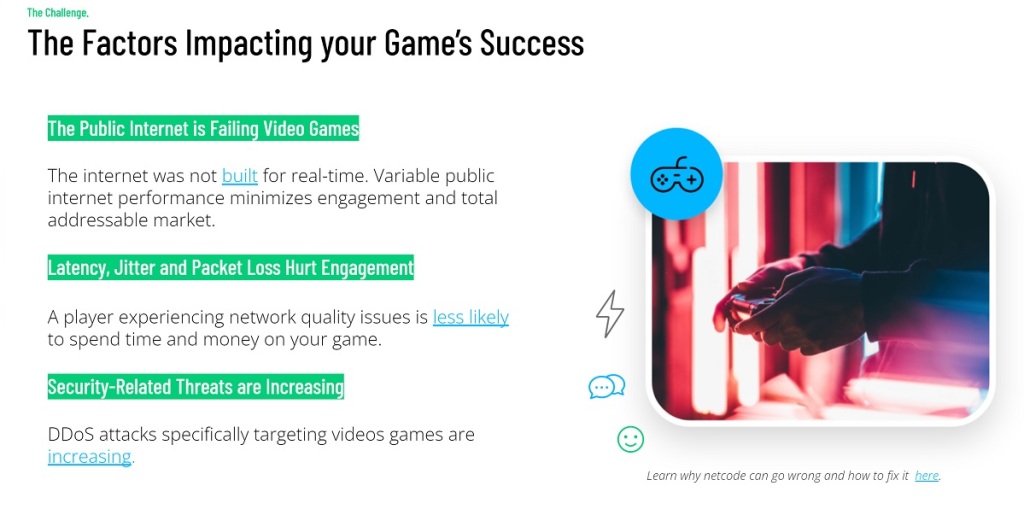Subspace will launch its parallel and real-time internet for gaming and the metaverse
feedproxy.google.com – 2021-10-26 15:30:27 – Source link
Join gaming leaders online at GamesBeat Summit Next this upcoming November 9-10. Learn more about what comes next.
Subspace is officially launching its parallel and real-time internet service for gaming and the metaverse on November 16.
In the past couple of years, Subspace has built out its parallel network using its own networks and hardware as well as partnerships with providers of dark fiber, or some of the excess capacity for the internet. And now it is rolling out its self-serve network-as-a-service in a few weeks. The network lets developers — such as the makers of real-time games — deliver real-time connectivity for their users.
“I saw this need where we live in a real-time world and the current internet will not be able to sustain in the future,” said Bayan Towfiq, CEO of Subspace, in an interview with GamesBeat.
Towfiq started working on this because the public internet is failing key applications that need real-time communication, such as games. It was never built for real-time interaction, and it is beset with problems such as latency, jitter, and packet loss that ultimately hurt engagement.
Webinar
Three top investment pros open up about what it takes to get your video game funded.
Watch On Demand
“For the past few years, our team at Subspace has built a network that is going to fundamentally change how multiplayer gaming is delivered,” said Towfiq. “Publishers that care about their customers have to see this. It reduces lag, reaches a larger audience, and increases security. Now we are taking that global private network to a wider audience.”

Above: Subspace CEO Bayan Towfiq (right), and CTO William King.
Image Credit: Subspace/Adib Towfiq
Los Angeles-based Subspace can’t talk about its partners yet, but I’ve been on private roundtables with them on a couple of occasions where we’ve talked about what needs to happen to make the metaverse a reality. (We’re going to do these sessions every few months since things are changing so fast). Subspace said it has game company customers who have hundreds of millions of players.
Towfiq said Subspace has built the fastest, most stable, highly available, and secure network for internet applications. Its tagline is “every millisecond counts.”
Some of this is intuitive. Speedtest tells me that I have a ping time of 11 milliseconds to a server in San Jose, California, but Meter.net says I have a 61-millisecond ping time to a server in Dallas, Texas. When I’m playing Call of Duty: Warzone and I’m about to blast at an enemy, the last thing I want is to see the screen stutter and to have the enemy get the drop on me because my computer and connection are too slow.
Subspace has deployed a global private network, including a dedicated fiber-optic backbone, patented internet weather mapping, and custom hardware in hundreds of cities. This network pulls gaming traffic off the internet close to users and ensures the fastest and most stable path.
But Towfiq said that the technology goes beyond a faster network.
“Subspace, for the first time, lets existing games and internet applications bring private networking to every internet-connected device without changes to code, VPN clients, or on-premise hardware,” he said.

Above: Subspace is fixing real-time communication on the internet.
Image Credit: Subspace
And companies like Activision Blizzard don’t want players to get mad at them for latency problems that have more to do with the underlying structure of the internet than any flaws in the games themselves.
Latency is the time it takes a data signal to travel from one point on the internet to another point and then come back. This is measured in milliseconds (a thousandth of a second). If the lag is bad, then fast-action games don’t work well. Your frame rate can slow down to a crawl, or you can try to shoot someone and miss because, by the time you aim at a spot, the person is no longer there. Subspace believes it can generate 80% lower latency for players across 60 countries.
How it works

Above: Subspace was founded in 2018.
Image Credit: Subspace
You can think of what Subspace is building as a ghost internet, or a network of private servers that can be used by multiplayer gamers to bypass the bottlenecks on the internet. Subspace fixes those bottlenecks, sort of how Waze helps you — or at least once helped you — find your way around car traffic jams. The company raised $26 million in April 2020 for this purpose. It’s kind of like a content delivery network (CDN) for games.
It deals with problems about why the internet, which was originally designed for redundancy in the case of a nuclear war, is screwed up. Internet packets have to hop from one kind of infrastructure, owned by one company, to another, owned by another company. Those handoffs take time, and routing isn’t as efficient as it is supposed to be.
The people who need this kind of traffic unclogging the most are multiplayer gamers, as the coronavirus has condemned us to our homes and doomed many of us to entertain ourselves with multiplayer games, such as Call of Duty: Warzone (my particular obsession), League of Legends, or FIFA. Subspace had to come up with a combination of software and hardware that sets up a kind of parallel internet, or one that routes around the problem traffic and creates fast lanes for the game companies that pay Subspace for the speed.

Above: All the challenges slowing down your games.
Image Credit: Subspace
“We’re building an internet for real time, where games are the biggest part and we think it could be a lot better,” said Ron Williams, vice president of operations at Subspace. “We’re still limited by the speed of light and the number of datacenters out there. There’s still a lot of work to do on the network. But we can take the internet as it is today and make it a lot better and lift a lot of constraints off of game developers. The problem is that nobody thought of these things in 1969.”
Subspace’s network platform deploys, operates, and AI optimizes and scales the highest performing proxy services for a real-time application. And it requires no end-user hardware or configuration changes, as it is implemented via a simple configuration to proxy game traffic to Subspace. And it provies always-on protection against hacker attacks, known as distributed denial of service (DDoS) attacks.
In the short term, Subspace increases the number of players with playable ping, which increases the total addressable market and player engagement.
If Subspace can make the satisfaction of a playing an online game get better, then it could increase the amount of time that people will spend in a game. A 2020 report said that gamers average 6.3 hours of play per week globally, with players ages 18 to 45 averaging over seven hours. This doesn’t count the additional 3.5 and 4.6 hours weekly that women and men, respectively, spend watching other people play video games, with younger groups investing more hours.
Companies like Epic Games and Roblox are adding concerts, and by adding a new form of entertainment to a game, they give people more reasons to come back and spend more time in their worlds. That’s how the metaverse eventually happens, when we get enough reasons to spend all day in it.
Hilmar Veigar Petursson, CEO of Eve Online maker CCP Games, said in an email to GamesBeat that he got to know Subspace in the spring of 2019, when the company faced some heavy distributed denial of service attacks. Though his company didn’t wind up using them, Petursson was impressed enough to become an investor in subspace.
“I became very impressed with their depth of knowledge and how they are building up their network. I even became an investor,” he said. “The tech itself is very impressive and solves a problem which applies widely but is particularly acute with games and gamers and often affects the experience a lot more than companies thing, the routing on the internet is so bad.”
The metaverse

Above: Subspace is increasing its reach with its network-as-a-service.
Image Credit: Subspace
It so happens that making the internet good for gaming also makes it good for the metaverse, the universe of virtual worlds that are all interconnected, like in novels such as Snow Crash and Ready Player One.
“The metaverse is not possible with today’s internet,” said Twofiq. “Much like multiplayer online games are limited by current network conditions, the metaverse is only possible with private network capabilities delivered to any destination on the internet. With Subspace, virtual interactions can span continents, with minimal lag and with high availability.”
Matthew Ball, a metaverse futurist and CEO of Epyllion, has invested in Subspace. In a think piece on the metaverse, Ball wrote, “The human threshold for latency is incredibly low in video gaming, especially versus other mediums. Consider, for example, traditional video versus video games.”
He said the average person doesn’t even notice if audio is out-of-sync with video unless it arrives more than 45ms too early or more than 125ms late (170ms total). Acceptability thresholds are even wider, at 90ms early and 185ms late (275ms). With digital buttons, such as a YouTube pause button, we only think our clicks have failed if we don’t see a response after 200–250ms.
“In triple-A games, avid gamers are frustrated at 50ms and even non-gamers feel impeded at 110ms,” Ball wrote. “Games are unplayable at 150ms. Subspace finds that on average, a 10ms increase or decrease in latency reduces or increases weekly playtime by 6%. That’s an extraordinary exposure — and one no other business faces.”

Above: Subspace delivers networking for hundreds of milliosn of players.
Image Credit: Subspace
Subspace finds that roughly three-quarters of all internet connections in the Middle East are outside playable latency levels for dynamic multiplayer games, while in the United States and Europe, a quarter are bad. This mostly reflects the limitations of broadband infrastructure, not server placement, Ball wrote.
Subspace, for example, deploys hardware across hundreds of cities in order to develop ‘weather maps’ for low latency network pathfinding, operates a networking stack that then coordinates the needs of a low latency application with the many third-parties that make up this path, and has even built an optical network that splices across various fiber networks to further shorten the distance between servers and minimize the use of non-fiber cabling, wrote Ball.
“Our mission is to deliver real-time connectivity from anywhere to anywhere, so that the metaverse can happen,” Towfiq said. “One of the requirements for the metaverse is that it be created and operated by a range of contributors, with accessibility for everyone.”
Features of the dedicated network used by the enterprise companies are now accessible, via self-service, by any internet application. While game companies create massively multiplayer online experiences — like Amazon’s New World — they don’t think so much about the interconnected services that are usually carried about by other companies that run the backbone of the internet. That’s why the game companies had to turn to Subspace.
“You don’t have to build a whole bunch of specialized tech for your game,” Williams said. “In the metaverse is when we know that the interoperability problems really start to multiply.”
Brendan Greene, creator of PlayerUnknown’s Battlegrounds (PUBG), has proposed creating a planet-sized world called Artemis that will require real-time access to an extremely detailed world. He realizes that he needs the latest in multiplayer gaming technology to pull off the huge world in the next five years or so. It’s such ambitions of game companies that will lead to the creation of the metaverse, Twofiq said.
In the long term, with the improved end-user experience, more consumers experience the persistent, synchronous quality of the metaverse, and it becomes accessible to a limitless number of concurrent users, Subspace said. But today’s internet is holding back the vision of the metaverse, as it will require 100% uptime and ultra-low latency, like the kind we saw in the Steven Spielberg film Ready Player One.

Above: Subspace is building a parallel internet.
Image Credit: Subspace
Yet we regularly see the impact of network latency on real-time interaction, exacerbated by pandemic and increasingly demands of the internet – remote work. If your Zoom call drops in the middle of a critical meeting, you don’t care whose fault it is. You want it fixed. That’s where Subspace comes in, Towfiq said. When the applications are no longer constrained by the network, then the metaverse is possible.
Subspace’s plan is to reduce latency and lag in games on a massive scale. It will use its infrastructure to help massively multiplayer, online game experiences thrive, and it will build more infrastructure to address more real-time applications, to deliver real-time connectivity from anywhere to anywhere. Twofiq’s goal, in the long run, is to get the entire world online.
Twofiq, a veteran of telecommunications and founder of Flowroute (sold to West/Intrado), founded the company in 2018. Part of his ambition is to make the internet accessible to the global population, not just the developed countries because without everyone in the world, it’s not really a metaverse.
GamesBeat
GamesBeat’s creed when covering the game industry is “where passion meets business.” What does this mean? We want to tell you how the news matters to you — not just as a decision-maker at a game studio, but also as a fan of games. Whether you read our articles, listen to our podcasts, or watch our videos, GamesBeat will help you learn about the industry and enjoy engaging with it.
How will you do that? Membership includes access to:
- Newsletters, such as DeanBeat
- The wonderful, educational, and fun speakers at our events
- Networking opportunities
- Special members-only interviews, chats, and “open office” events with GamesBeat staff
- Chatting with community members, GamesBeat staff, and other guests in our Discord
- And maybe even a fun prize or two
- Introductions to like-minded parties
Become a member





